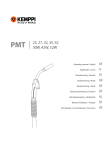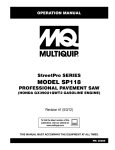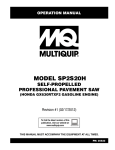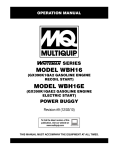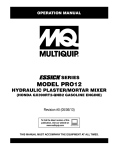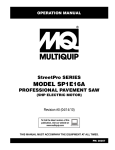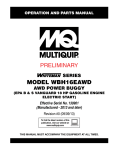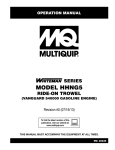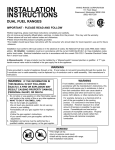Download MULTIQUIP tp7X Specifications
Transcript
Operation Manual MODEL TP7X Tile Saw (Electric Motor) Revision #0 (03/04/11) To find the latest revision of this publication, visit our website at: www.multiquip.com THIS MANUAL MUST ACCOMPANY THE EQUIPMENT AT ALL TIMES. Proposition 65 Warning Engine exhaust and some of its constituents, and some dust created by power sanding, sawing, grinding, drillingandotherconstructionactivities contains chemicals known to the State of California to cause cancer, birth defects and other reproductive harm. Some examples of these chemicals are: Leadfromlead-basedpaints. Crystalline silicafrombricks. Cementandothermasonryproducts. Arsenicandchromiumfromchemically treatedlumber. Your risk from these exposures varies, depending on how often you do this type of work. To reduce your exposure to these chemicals: ALWAYS work in a well ventilated area, and work with approved safety equipment, such as dust masks that are specially designed to filter out microscopic particles. page 2 — TP7X TILE SAW • operation manual — rev. #0 (03/04/11) Silicosis/Respiratory Warnings WARNING WARNING SILICOSIS WARNING RESPIRATORY HAZARDS Grinding/cutting/drilling of masonry, concrete, metal and other materials with silica in their composition may give off dust or mists containing crystalline silica. Silica is a basic component of sand, quartz, brick clay, granite and numerous other minerals and rocks. Repeated and/or substantial inhalation of airborne crystalline silica can cause serious or fatal respiratory diseases, including silicosis. In addition, California and some other authorities have listed respirable crystalline silica as a substance known to cause cancer. When cutting such materials, always follow the respiratory precautions mentioned above. Grinding/cutting/drilling of masonry, concrete, metal and other materials can generate dust, mists and fumes containing chemicals known to cause serious or fatal injury or illness, such as respiratory disease, cancer, birth defects or other reproductive harm. If you are unfamiliar with the risks associated with the particular process and/or material being cut or the composition of the tool being used, review the material safety data sheet and/or consult your employer, the material manufacturer/supplier, governmental agencies such as OSHA and NIOSH and other sources on hazardous materials. California and some other authorities, for instance, have published lists of substances known to cause cancer, reproductive toxicity, or other harmful effects. Control dust, mist and fumes at the source where possible. In this regard use good work practices and follow the recommendations of the manufacturers or suppliers, OSHA/NIOSH, and occupational and trade associations. Water should be used for dust suppression when wet cutting is feasible. When the hazards from inhalation of dust, mists and fumes cannot be eliminated, the operator and any bystanders should always wear a respirator approved by NIOSH/MSHA for the materials being used. TP7X TILE SAW • operation manual — rev. #0 (03/04/11) — page 3 Table of Contents TP7X Tile Saw Proposition 65 Warning............................................ 2 Silicosis/Respiratory Warnings................................. 3 Table Of Contents..................................................... 4 Safety Information................................................. 6-9 Specifications......................................................... 10 Dimensions............................................................. 11 General Information................................................ 12 Saw Components.............................................. 14-15 Electric Motor Components/Set-Up........................ 16 Set-Up............................................................... 17-20 Sawing Guides .............................................. 20-21 Operation........................................................... 22-23 Maintenance...................................................... 24-27 Wiring Diagram (Electric Motor)............................. 28 Troubleshooting (Blade).......................................... 30 Troubleshooting (Saw)............................................ 31 NOTICE Specifications are subject to change without notice. page 4 — TP7X TILE SAW • operation manual — rev. #0 (03/04/11) Notes TP7X TILE SAW • operation manual — rev. #0 (03/04/11) — page 5 Safety Information Do not operate or service the equipment before reading the entire manual. Safety precautions should be followed at all times when operating this equipment. Failure to read and understand the safety messages and operating instructions could result in injury to yourself and others. Potential hazards associated with the operation of this equipment will be referenced with hazard symbols which may appear throughout this manual in conjunction with safety messages. Symbol Safety Hazard SaFeTy meSSageS The four safety messages shown below will inform you about potential hazards that could injure you or others. The safety messages specifically address the level of exposure to the operator and are preceded by one of four words: Danger, WarnIng, CauTIon or noTICe. SaFeTy SymBoLS Rotating parts hazards Cutting and crushing hazards Danger Indicates a hazardous situation which, if not avoided, WILL result in DeaTH or SerIouS InJury. Electric shock hazards WarnIng Indicates a hazardous situation which, if not avoided, CouLD result in DeaTH or SerIouS InJury. CauTIon Indicates a hazardous situation which, if not avoided, CouLD result in mInor or moDeraTe InJury. NOTICE Addresses practices not related to personal injury. page 6 — TP7X TILE SAW • operation manual — rev. #0 (03/04/11) Safety Information generaL SaFeTy CauTIon never operate this equipment without proper protective clothing, shatterproof glasses, respiratory protection, hearing protection, steel-toed boots and other protective devices required by the job or city and state regulations. Avoid wearing jewelry or loose fitting clothes that may snag on the controls or moving parts as this can cause serious injury. never operate this equipment when not feeling well due to fatigue, illness or when under medication. never operate this equipment under the influence of drugs or alcohol. NOTICE This equipment should only be operated by trained and qualified personnel 18 years of age and older. Whenever necessary, replace nameplate, operation and safety decals when they become difficult read. Manufacturer does not assume responsibility for any accident due to equipment modifications. Unauthorized equipment modification will void all warranties. never use accessories or attachments that are not recommended by Multiquip for this equipment. Damage to the equipment and/or injury to user may result. aLWayS know the location of the nearest fire extinguisher. aLWayS know the location of the nearest first aid kit. aLWayS know the location of the nearest phone or keep a phone on the job site. Also, know the phone numbers of the nearest ambulance, doctor and fire department. This information will be invaluable in the case of an emergency. aLWayS clear the work area of any debris, tools, etc. that would constitute a hazard while the equipment is in operation. No one other than the operator is to be in the working area when the equipment is in operation. aLWayS check the equipment for loosened threads or bolts before starting. Do noT use the equipment for any purpose other than its intended purposes or applications. TP7X TILE SAW • operation manual — rev. #0 (03/04/11) — page 7 Safety Information SaW SaFeTy CauTIon Danger never operate the equipment in an explosive atmosphere or near combustible materials. An explosion or fire could result causing severe bodily harm or even death. never operate the saw without blade guards and covers in place. Exposure of the diamond blade must not exceed 180 degrees. Verify the motor start switch is set to the OFF position before installing a blade. WarnIng Accidental starting can cause severe injury or death. aLWayS place the ON/OFF switch in the OFF position. Keep hands away from moving parts at all times. never disconnect any emergency or safety devices. These devices are intended for operator safety. Disconnection of these devices can cause severe injury, bodily harm or even death. Disconnection of any of these devices will void all warranties. aLWayS inspect blade before each use. The blade should exhibit no cracks, dings, or flaws in the steel centered core and/or rim. Center (arbor) hole must be undamaged and true. NOTICE Use proper blades and follow blade manufacturer’s recommendations. Match the blade RPM (blade shaft RPM) to the recommended blade surface feet per minute (SFPM). Ensure the blade-mounting bolt is tightened adequately CauTIon aLWayS ensure saw is securely placed on appropriate blocks or jackstands when maintenance requires elevation of the saw. If the machine malfunctions, stop the saw immediately and secure it. Fix the problem as soon as possible. NOTICE aLWayS keep the machine in proper running condition. Fix damage to machine and replace any broken parts immediately. Make sure there is no buildup of grease, oil or debris on the machine. aLWayS store equipment properly when it is not being used. Equipment should be stored in a clean, dry location out of the reach of children and unauthorized personnel. BLaDe SaFeTy aLWayS examine blade flanges for damage and excessive wear. Ensure the blade is marked with an operating speed greater than the spindle speed of the saw. Only cut the material that is specified for the diamond blade. Read the specification of the diamond blade to ensure the proper tool has been matched to the material being cut. If wet cutting, ensure a WeT CuTTIng blade is being used and that the water supply system to the blade is properly functioning and being used. Do noT drop the diamond blade on ground or surface. Ensure that the blade is mounted for proper operating direction. Adhere to the blade manufacturer’s recommendations on handling, storage and safe usage of blades. WarnIng Rotating blade can cut and crush. aLWayS keep hands and feet clear while operating the saw. page 8 — TP7X TILE SAW • operation manual — rev. #0 (03/04/11) Safety Information eLeCTrIC moTor SaFeTy NOTICE LIFTIng SaFeTy CauTIon Operate electric motor only at the specified voltage indicated on the nameplate. never allow any person or animal to stand underneath the equipment while lifting. Do noT spray water onto electric motor. Some saws are very heavy and awkward to move around. Use proper heavy lifting procedures. aLWayS disconnect AC power plug from power source before moving saw, changing blade, or performing maintenance. aLWayS make sure the ON/OFF switch on the electric motor is in the OFF position when not in use and before inserting the saw’s power plug into an AC receptacle. power Cord/Cable Safety Danger never let power cords or cables lay in water. never use damaged or worn cables or cords when connecting equipment to generator. Inspect for cuts in the insulation. never grab or touch a live power cord or cable with wet hands. The possibility exists of electrical shock, electrocution or death. Make sure power cables are securely connected. Incorrect connections may cause electrical shock and damage to the saw. CauTIon Ensure that cables and cords will not be tripped over or trapped underneath the saw. Do noT lift machine to unnecessary heights. never lift the equipment while the motor is running. TranSporTIng SaFeTy NOTICE aLWayS shutdown motor before transporting. aLWayS tie down equipment during transport by securing the equipment with rope. Ensure that the diamond blade does not come into contact with the ground or surface during transportation. never transport the saw to or from the job site with the blade mounted. envIronmenTaL SaFeTy NOTICE Dispose of hazardous waste properly. Examples of potentially hazardous waste are used motor oil, fuel and fuel filters. Do noT use food or plastic containers to dispose of hazardous waste. Do noT pour waste, oil or fuel directly onto the ground, down a drain or into any water source. Never use the cable to pull out the plug from the power source. NOTICE aLWayS make certain that proper power or extension cord has been selected for the job. Protect the cable from heat, oil, and sharp edges. TP7X TILE SAW • operation manual — rev. #0 (03/04/11) — page 9 SPECIFICATIONS Table 1. Saw Specifications Model Blade Capacity Blade RPM Arbor Size Blade Guard Blade Shaft Bearings Cutting Head Conveyor Cart Drive System Max. Depth of Cut Straight Cut Diagonal Cut Water Tray Water Pump Weight TP7X 7 in. (178 mm) 6000 5/8 in. (15.875 mm) Cast Aluminum Water-Cooled Cast Aluminum, Adjustable Aluminum with roller bearings, injected molded rubber pad, transportation lock T-belt 1-3/4 in. (44.5 mm) 20 in. (508 mm) 14 in. (356 mm) x 14 in. (356 mm) Size Tile ABS 115V, 60 Hz — 230 GPH 55 lbs. (25 kg) Table 2. Electric Motor Specifications Horsepower 1 Volts 115 Amps 15 Motor RPM 21,500 RPM Cycle 60 Phase 1 Class E page 10 — TP7X TILE SAW • operation manual — rev. #0 (03/04/11) dimensions C B A Figure 1. Dimensions Table 3. Dimension Reference Letter Dimensions A 31.9 in. (811 mm) B 19.6 in. (49‑8 mm) C 20.4 in. (518 mm) TP7X TILE SAW • operation manual — rev. #0 (03/04/11) — page 11 general information The TP7X is a powerful, robust saw designed to professionally handle large-sized cuts on ceramics, stone, and masonry materials. A sturdy steel precision frame and easily removable ABS water tray provides overall durability and longevity. Accessories/Replacement Parts This saw is equipped with a trusted 1 HP electric motor that operates on standard 115 V power and is designed with thermal overload and fan air cover protection. Features An innovative water-cooled bearing assembly works in conjunction with the water pump to keep key bearing components running cooler. The TP7X saw comes complete with premium blade and high flow water pump. Dry Cutting Applications The TP7X tile saw is shipped from the factory for wet-cutting saw applications, however it can be used for dry-cutting saw applications. The most import thing to remember is to disconnect the water pump. The water pump is cooled by the flow of water, and failure to disconnect the pump (when running dry) will cause pump failure. NOTICE NEVER have the water pump engaged when dry cutting applications are involved. Blade Applications This saw has been designed to incorporate the use of diamond blades as the cutting tool. The optimum performance of this saw is best evidenced by using 7-inch (178 mm) diamond blades that match the material being cut. Ask your dealer, or call Multiquip about your specific cutting application. If desired, the TP7X tile saw can be equipped with a support stand. This stand is ideal when the saw needs to be placed on a secure reliable platform. Rugged Portable Frame Assembly — Sturdy steel frame design with handles for easy transport. Electric Induction Motor — UL/CSA approved 115 V 60 Hz, 1 HP electric motor with thermal overload and fan cover protection. Water Tray — Sturdy ABS water tray that is easily removable for cleaning. Cutting Table — Rugged cast aluminum table with heavy-duty injected molded rubber padding and extension table. Industrial ball bearing rollers ensure smooth, precise cart movement. Water Pump — Powerful submersible pump provides high volume water flow. Water-Cooled Blade Shaft Bearing Assembly — High flow water circulating system designed to keep crucial bearing components running cooler. Blade Guard — Hardy cast guard with blade brushes designed to evenly distribute water to the blade, and to easily position for blade changes. Diamond Blade — 7-inch (178 mm) premium tile blade included. page 12 — TP7X TILE SAW • operation manual — rev. #0 (03/04/11) notes TP7X TILE SAW • operation manual — rev. #0 (03/04/11) — page 13 saw components 3 5 8 4 2 10 7 15 9 11 12 6 1 13 22 20 17 18 19 21 16 14 Figure 2. Saw Components page 14 — TP7X TILE SAW • operation manual — rev. #0 (03/04/11) saw components Figure 2 shows the location of the basic components of the TP7X saw. Listed below is a brief explanation of each component. 1. AC Power Cord — Plug this cord into a 125 VAC receptacle when starting of the electric motor is required. 2. V-belt Cover — Remove this cover to access the drive V-belt. NEVER operate the saw with the V-belt cover removed 3. Rubber Splash Guard — Keeps water from splashing from the blade. 4. Electric Motor — This unit uses a 115V, 60 Hz, 1 HP electric motor. 5. Overcurrent Breaker Button — When a thermal overload condition exists, press this button to reset the breaker. Allow time for the electric motor to cool down before reseting the breaker. 6. Cutting Blade — This unit uses a 7-inch (178 mm) premium diamond blade. Always use recommended Multiquip cutting blades. When mounting of the cutting blade is required, remove the spindle bolt and outside blade flange. Align cutting blade with inside flange arbor and reassemble spindle and outside blade flange. 7. Power ON/OFF Switch — To turn on the saw place in the ON position. Place in the OFF position to shut down the saw. 8. Water Pump Power Receptacle — Plug the water pump power cord into this AC receptacle. 9. Blade Guard — Protects the user from the cutting blade. NEVER operate the saw with the blade guard removed. 10. Blade Guard Adjustment Knob — Turn knob clockwise to loosen and remove blade guard. Turn counterclockwise to tighten. 11. Blade Guard Brushes — Prevents foreign matter and debris from accumulating on the saw blade.Replace brushes immediately when they become worn or damaged. 12. Cutting Table — Place material to be cut on this rubber padded table. For ease of cutting, this table has been placed on rails so that it can easily slide back and forth. 13. Ruler Backstop — When cutting, place material against backstop. Use measurement rail (ruler) to determine where material is to be cut. 14. Stopper — Place stopper in water tray when filling with water. 15. Cutting Head Adjustment Knob — Turn knob clockwise to loosen and position cutting head to desired height. Turn counterclockwise to tighten. 16. Water Tray — When wet cutting is required, fill with clean fresh water. Make sure submersible pump is totally immersed in water. 17. Electric Water Pump — The electric water pump for this saw requires 115 VAC. Plug power cord of electric water pump into AC receptacle located on conduit box. NEVER run pump dry. Pump must be immersed in water. 18. Water Lines — Replace the clear vinyl tubing water lines when they become brittle, worn or clogged. Water kits are available through your Multiquip dealer. 19. Maintenance Wrench — Use this multi-purpose wrench when performing maintenance or repairs on the saw. 20. MasterGuide Template Base — Mounts to ruler backstop to ensures precision while making cuts. 21. Bearing Housing — Houses permanently lubricated ball bearings to allow motor shaft to rotate smoothly. 22. Metal Frame Handles — There are two carrying handles on each side of the saw. Grip these handles when transporting of the the saw is required. TP7X TILE SAW • operation manual — rev. #0 (03/04/11) — page 15 electric motor components/set-up Electric Motor Components Figure 3 shows the location of the components of the electric motor. 115 VAC, 60 Hz SINGLE -PHASE ELECTRIC MOTOR OVERCURRENT BREAKER BUTTON 3. Slide water pump onto U-shaped bracket located at the bottom of the frame. See Figure 6. 4. Slide cutting head onto the post. Secure cutting head to the shaft using provided flat washer, lock washer and nut. Attach cutting depth control knob and washers to the cutting head through the slot located underneath the belt guard. See Figure 4. 5. Mount blade guard onto shaft protruding from the side of the cutting head. Secure the blade guard in place using the provided serrated washer and blade guard knob. CUTTING HEAD BLADE GUARD KNOB ELECTRIC ELECTRIC WATER MOTOR PUMP AC ON/OFF SWITCH RECEPTACLE Figure 3. Electric Motor Components Saw Set-Up BLADE GUARD SHAFT CUTTING DEPTH CONTROL KNOB WATER TRAY WARNING Whenever cleaning, adjusting or lubricating any part of the saw, make certain to place the power ON/OFF switch in the OFF position and disconnect the plug from the power source. 1. Open the shipping container carefully, lift the saw by its carrying handles and place it on a suitable table or platform. Make sure the table or platform can support the weight of the saw. 2. Make sure that the following items are found in the container: Saw Saw Blade Water Tray Water Pump Drain Plug Owner’s Manual Universal Wrench MasterGuide Template Base Figure 4. Saw Assembly 6. If using the optional support stand, assemble as described in the Support Stand Assembly section. Make sure that the saw is secured on the support stand as instructed. support Stand Assembly (Optional) Refer to Figure 5 for location of components. 1. Remove the folding stand from its box. 2. Swing the working bench upright. Open the two legs and place the work bench on top of the folding stand. 3. After teh saw stand is assembled, seat the saw securely on top of the stand. page 16 — TP7X TILE SAW • operation manual — rev. #0 (03/04/11) set-up 6. Insert the water pump power plug into the outlet receptacle on the electric motor conduit box as shown in Figure 7. ELECTRIC MOTOR CONDUIT BOX POWER PLUG ELECTRIC WATER PUMP AC RECEPTACLE WATER PUMP Figure 5. Support Stand Assembly connecting the water Pump Refer to Figure 6. 1. Place the pump into the middle of the water tray along its side so that the water outlet is positioned horizontally. 2. Attach the water hose coming from the blade guard and bearing housing to the water pump. 3. Install drain plug in water tray. 4. Fill the water tray with clean fresh water. The water pump intake must always be fully covered by water. Also, keep the pump intake free of sludge, debris and other materials that may accumulate in the tray. 5. Make certain that the water hose will not come in contact with the blade or interfere with any moving parts. Figure 7. Water Pump Power Connection WARNING Disconnect the pump before attempting to handle the pump. NEVER operate pump without water in the tray. NOTICE The above procedure is for wet cutting applications only. NEVER dry cut with the pump connected to an AC power source. Running the pump dry will damage the pump. ALWAYS disconnect the pump’s power cord when dry cutting. BLADE GUARD WATER PUMP WATER HOSES BEARING HOUSING DRAIN PLUG Figure 6. Connecting the Water Pump TP7X TILE SAW • operation manual — rev. #0 (03/04/11) — page 17 set-up Blades WARNING Failure to thoroughly inspect the blade for operational safety could result in damage to the blades or the saw and may cause serious injury to the user or others in the operating area. Inspect the blade flanges and shaft for damage before installing the blade. Blade Components Diamond blades are recommended for your saw. Ask your Multiquip dealer about your specific cutting application. Figure 8 highlights the components of a diamond blade. 2 1 3 4 SPECIFICATIONS MAX. RPM 5 7 3. Directional Arrow — Check to ensure that the blade is oriented properly on the spindle for sawing. Reference the directional arrow on the blade and place it so the direction of rotation “downcuts” with the turn of the shaft. 4. Diamond Segment or Rim — Ensure that there are no cracks, dings, or missing portions of the diamond segment/rim. DO NOT use a blade that is missing a segment or a portion of the rim. Damaged and/or missing segments/rims may cause damage to your saw and injury to the user or others in the operating area. 5. Specifications — Ensure that the blade specifications, size, and diameter properly match up to the sawing operation.Wet blades must have water to act as a coolant. Utilizing a diamond blade not matched properly to the task may result in poor performance and/or blade damage. 6. Arbor Hole — It is essential that the arbor hole diameter properly matches the shaft arbor, and that it is free from distortions. Correct blade flanges (collars) must be used. The inside face of the flanges must be clean and free of debris. An out of round arbor condition will cause damage to the blade and the saw. 7. MAX RPM — This RPM reference is the maximum safe operating speed for the blade selected. NEVER exceed the max RPM on the diamond blade. Exceeding the MAX RPM is dangerous, and may cause poor performance and may damage the blade. All blades used must be designed for the maximum spindle RPM. Cutting Depth 6 Figure 8. Diamond Blade 1. Stress Relief Holes (Gullets) — Check the steel core for cracks that may have propagated from the slots and/or gullets. Cracks indicate extreme fatigue failure and if sawing continues, catastrophic failure will occur. 2. Edge of the Steel Core — Check the diameter edge for discoloration (blue oxidation) indicating an overheating condition caused by insufficient cooling water/air. Overheating of blades may lead to loss of core tension and/or increase the possibility for blade failure. Check to make sure the steel core’s width is uniform about the rim of the blade, and not succumbing to an “under cutting” condition brought about by highly abrasive material or improper under cutting core protection. The recommended cutting depth is 1/4" (6 mm) below the cutting table surface. To adjust the cutting depth, loosen the cutting head adjustment knob so that the blade is 1/4" below the top of the cutting table's surface. See Table 4 to determine cutting depth by blade diameter. WARNING Setting the blade too low may damage the cutting table and if set too high, the blade may grab the material being cut, causing damage and possibly injury. Table 4. Blade Diameter vs. Cutting Depth Blade Diameter Cutting Depth 7 in. (178 mm) 1-3/4 in. (44.5 mm) page 18 — TP7X TILE SAW • operation manual — rev. #0 (03/04/11) set-up Blade Installation Refer to Figure 9 and the following instructions for installing the blade. 1. Loosen blade guard adjustment knob located at the rear of the blade guard. Carefully raise the cutting head to its highest position and secure it into place by tightening the blade guard adjustment knob. 2. Remove the blade shaft nut and outer flange. If a blade has been mounted, hold the blade with one hand and use the other hand to loosen the nut with the universal wrench. Remove existing blade. 3. Mount new blade, but make certain the arrow on the blade coincides with the rotation direction of the shaft. Ensure the capacity of the blade guard matches the diameter of your cutting blade. 4. Attach outer flange and blade shaft nut. Hold the blade with one hand and use the other hand to tighten the nut with the universal wrench. Make certain the flanges are pressed flush against the blade and that the nut is firmly tighthened, but do not over tighten. 5. Loosen blade guard adjustment knob, lower the blade guard, and retighten the knob. 6. Slightly loosen the cutting head adjustment knob, lower the cutting head so that the blade is 1/4" (6 mm) below the surface of the cutting table. Tighten the adjustment knob firmly to hold the cutting head in place. BLADE GUARD BLADE GUARD ADJUSTMENT KNOB BLADE SHAFT NUT BLADE OUTER FLANGE BLADE SHAFT INNER FLANGE Figure 9. Blade Installation See Table 5 for proper blade use guidelines. Table 5. Proper Blade Use Dos Don’ts Inspect blades daily for cracks or uneven wear. Do not operate the saw without safety guards in place. Always use appropriate blades for material being cut. Do not operate the saw with blades larger than 7 in. (178 mm) Inspect arbor shaft for uneven wear before mounting Do not cut dry with blades marked “Use Wet”. blade. Always use blades with the correct arbor shaft size. Do not exceed manufacturer’s recommended maximum RPM. Ensure that blade is mounted in the correct direction. Do not force blade into material. Let blade cut at its own speed. Use proper safety equipment when operating the saw. Do not make long cuts with dry blades. Allow them to air cool. Always have a continuous flow of water on both sides of blade. Do not use the edge or side of blade to cut or grind. Secure the blade to the arbor with a wrench. Do not attempt to cut a radius or curve. Inspect segment blades for segment cracking or loss. Do not cut too deep or too fast into the material. Do not use damaged blades. Do not cut any material not recommended by blade manufacturer. TP7X TILE SAW • operation manual — rev. #0 (03/04/11) — page 19 set-up/sawing guides Connecting the Power 1. Place the power ON/OFF switch (Figure 10) in the OFF position (down). 2. Connect an extension cord of adequate current carrying capacity to the power plug on the electric motor. 3. MAKE CERTAIN that the correct size extension cord is used. Undersized wires will burn out motors. Use Table 6 to determine the correct extension cord size. Motor 1 HP Table 6. Extension Cord Sizes 75 ft 50 ft 25 ft Voltage (7.6 m) (15. 2 m) (22.9 m) VAC Long Long Long 115 No. 12 No. 10 No. 8 Figure 11. GFCI Receptacle Sawing Guides Using the Cutting Table 115 VAC, 60 Hz SINGLE -PHASE ELECTRIC MOTOR The ruler guide has inches and centimeters marked along the top to allow convenient measurements and to promote precision cuts. See Figure 12. OVERCURRENT BREAKER BUTTON ELECTRIC ELECTRIC WATER MOTOR PUMP AC ON/OFF SWITCH RECEPTACLE CONNECT TO 115/230 VAC POWER SOURCE 4. Plug the free end of the extension cord into an AC power receptacle. Whenever possible use a GFCI receptacle (Figure 11) to reduce the risk of electrical shock. A rip guide should be used with the cutting table to ensure precision while making cuts. MASTERGUIDE TEMPLATE BASE EXTENSION CORD Figure 10. Extension Cord Connection ADJUSTABLE RULER GUIDE OPTIONAL RIP GUIDE DANGER NEVER grab or touch a live power cord with wet hands, the possibility exists of electrical shock, electrocution, and even death! NEVER use a damaged or worn extension cable when connecting to a power source. Defective cables may cause damage to the saw’s electric motor or electrical shock. ALWAYS use a grounded (3-wire) extension cord and MAKE CERTAIN that the motor is connected to a properly grounded electric circuit. If possible use a ground fault circuit interrupter to protect the operator from possible electric shock. Figure 12. Cutting Table Using the MasterGuide Template Base 1. Set the template base (Figure 12) by positioning it on the desired dimension on the cutting table and tightening the universal clamp to the table. Make sure that the template base is firmly tightened. The template base can be used for 90° rip cuts from both the left and right side. The 45° diagonal cuts are quickly achieved with the specially designed fitted notches on the template base of 4", 6", 8" and 10"~14" tiles (Note the specifically shown dimensions on each notch). page 20 — TP7X TILE SAW • operation manual — rev. #0 (03/04/11) sawing guides 2. After the template base is positioned for the desired rip cut, place material flat against either side of the template base at the desired measurement. Using the Rip Guide 1. Set the rip guide (Figure 12) at the desired location on the ruler guide and tighten the threaded knob. Make sure that the rip guide is firmly tightened to avoid slippage. The rip guide can be used for 45° and 90° cuts. 2. After the rip guide is positioned, for the desired cut, place material flat against the rip guide and ruler guide. 3. Now you are ready to make your cut. Performing Diagonal Cuts 1. Place the corner of the material in the open slot of the measurement rail and adjust the template base to fit the correct tile size. 2. Line up the material being cut with the appropriate pre-marked lines on the cutting table. 3. Now you are ready to make your cut. Performing Miter Cuts Use the miter block to make miter cuts. See Figure 13. 1. Place the lip of the miter block on the ruler guide with the threaded knob facing you. 2. Position the miter block such that a tile laying flat against the block may rest its left-most edge within the vertical channel of the cutting table. Tighten the threaded knob to secure the miter block in place. 3. Place material onto miter block and you are ready to cut. Figure 13. Miter Block TP7X TILE SAW • operation manual — rev. #0 (03/04/11) — page 21 operation Start-up Procedure NOTICE Read and fully understand this manual before starting or attempting to operate the saw. Before starting the saw’s electric motor make sure that the Safety, General Information, and Set-Up sections have been completed and understood. DO NOT proceed until the above mentioned sections have been completed. WARNING NEVER lift the blade guard while the blade is rotating. The possibility exists of severe bodily harm if fingers or hands come in contact with the rotating saw blade. Wait for the blade to stop rotating before lifting the blade guard. 1. Place the material to be cut (Figure 14) on the cutting table against the backstop. NOTICE ALWAYS use the water feed system unless special dry cut blades are being used. If dry cutting is required, disconnect water pump. CUTTING TABLE MATERIAL WARNING ALWAYS wear approved eye and hearing protection before operating the saw. WARNING BACKSTOP Figure 14. Material Placement NEVER place hands or feet inside the belt guard or blade guard while the motor is running.ALWAYS shut the motor down before performing any kind of maintenance WARNING NEVER place hands and fingers near the cutting blade. The possibility exists of severe bodily harm if hands and fingers come in contact with rotating saw blade. WARNING DANGER ALWAYS be alert to the fact that there is a rotating blade on the saw and be extremely aware of your body position — especially your hands in relationship to the rotating blade. The possibility exists of severe bodily harm or even death if your body comes in contact with the rotating saw blade. 2. Turn the power ON/OFF switch (Figure 15) to the ON position with the blade away from the material to be cut, the cutting blade should begin to rotate. Before cutting remember to follow all safety rules referenced in this manual. ALWAYS ensure that the cutting blade has been mounted correctly. DANGER NEVER touch a live power cord with wet hands. The possibility exists of electrical shock, electrocution which could cause severe bodily harm, even death. Figure 15. Power ON/OFF Switch (ON) page 22 — TP7X TILE SAW • operation manual — rev. #0 (03/04/11) operation 3. Push the cutting table with the material, slowly and evenly until the cut is complete. Move the cutting table back and remove the cut pieces. 4. Avoid overloading the motor when cutting. However, the electric motor is protected with a manual-reset thermal overload switch that will turn the saw off if the motor is overheated. In the event that the switch is tripped, turn the “ON/OFF” switch to the “OFF” position and allow the motor to cool before attempting to restart. Shut down Procedure 1. Place the power ON/OFF switch (Figure 16) in the OFF position (down). Figure 16. Power ON/OFF Switch (OFF) 2. Wait for the cutting blade to stop rotating. 3. Disconnect the saw's AC power cord from the power source. NEVER leave the saw connected to a power source when unattended. This will prevent accidental starting. 4. Using a soft cloth, clean any excess debris or residue that may have accumulated on the saw. 5. Store saw in a clean dry location where it will be out of the reach of children. TP7X TILE SAW • operation manual — rev. #0 (03/04/11) — page 23 MAINTENANCE A good preventive maintenance program of regular inspection and care will increase life and improve the performance of the saw and cutting blades. WARNING Whenever cleaning, adjusting, or lubricating any part of the saw, MAKE CERTAIN to do the following: • Place power ON/OFF switch to the OFF position. • Disconnect power cord from AC source. • NEVER attempt to check the V-belt with the engine running. Severe bodily injury can occur. Basic Maintenance 1. Tighten loose nuts or screws and replace any cracked or broken parts. 5. After each day's use, run clean water through the water pump and water hoses. This extends pump and blade life. 6. After cleaning, remove all covers and adhesive tape. All screws or nuts which may have been loosened must be retightened. 7. Check the spindle bolt for tightness periodically. 8. Keep the drive belt tight. It is very important to replace worn belts as soon as possible. To adjust belt tension, loosen the four (4) motor mounting bolts and remove the belt guard. Tighten the adjusting nut on the back of the motor plate to increase the tension. Proper belt tension is 4-5 lbs. of force with approximately 3/16" of belt deflection measured at a point midway between the pulleys. Tighten the motor mounting bolts and reattach the belt guard. 2. Clean the machine frequently. DO NOT use aggressive cleaners (i.e. containing solvents). DO NOT use high high-pressure water jets, aggressive detergents or solutions and liquids with a temperature exceeding 86°. Use a fluff-free cloth only. Use a cloth which may be lightly moistened only for removing dust and dirt. Hard packed dirt can be removed with a soft brush. 9. MAKE CERTAIN that the cutting head is aligned properly. Misalignment can adversely affect blade life. DO NOT let any water/cleaning liquid/vapor penetrate into the electric motor, connectors/plugs, switches, etc. Cover all apertures, holes in the housing, connectors or plugs, etc, or seal them with adhesive tape. Use a soft, low-pressure water jet and a brush to rinse dirt and incrustations away. Be particularly careful when near hazardous parts of the machine (e.g. switch, motor). Clean the motor and switches only by wiping with a moist cloth. 11. Cutting blades must fit the arbor snugly. This is very important with diamond blades as pounding will occur and serious blade damage can result. If the arbor shoulder of the inner blade flange is grooved from blade slippage, the flange must be replaced. 3. Remove the belt guard and clean the pulleys. The belts and pulleys will wear rapidly if excessive dust builds up. 4. Clean the sludge that accumulates on the bottom of the water tray at least once a day and refill with clean water. It may be necessary to clean the tray out twice a day in heavy cutting. The sludge is abrasive and will shorten the life of the water pump and blades. 10. The blade flanges must have a diameter of 4". Undersized flanges will reduce blade life and cause breakage. Therefore, they should be replaced at once. 12. Inspect the cutting table periodically. Replace worn parts. 13. DO NOT “rinse” the bearings of the drive elements to prevent them from running dry. The ball bearings of the machine are permanently lubricated. 14. Replace the spindle bearings as soon as they begin to make any strange noises. Worn bearings can destroy blades very quickly. 15. Grease pivot bearings periodically. page 24 — TP7X TILE SAW • operation manual — rev. #0 (03/04/11) MAINTENANCE Maintenance intervals Use the following guidelines to perform maintenance on your saw. After every use of the machine Remove dirty water from container. Remove dirt and mud from the bottom of the container. Rinse the immersion pump with fresh water to prevent water pump clogging from residual dirt. After wet cleaning and before using the machine again Connect the machine to an electric power outlet equipped with a “GFCI” safety power breaker. If the safety power breaker cuts off the electrical power supply, do not try to operate the machine but have it checked by an authorized dealer first. Before not using the machine for a prolonged period of time Clean and lubricate all movable parts. DO NOT grease guide rails. Check that the immersion pump works properly. Turn on the cooling water tap and switch the machine on. If the pump does not give any water or only a little, switch the machine off at once. Clean the pump, or replace if necessary. Ambient temperature below 32°F / 0°C (operation in winter) To prevent the water in the pump and cooling system from freezing, remove the water after using the machine or when there will be a long break. Make sure that the cooling system is entirely drained so that there is no water left inside the pump and water hose. cLEANINg the water tray Refer to Figure 17. Lift the saw up from inside the water tray. 1. Remove the drain plug and drain any water left inside the water tray. 2. Flush water into tray while holding it upright to remove any sludge buildup. 3. Replace the saw back into the water tray. After not using the machine for a prolonged period of time Check that the stand is safely fixed. Check that all screw joints and nuts are fixed. Check that the cutting table is seated properly on the guide rails and that it easily moves along the entire length of the rails. With the saw blade removed, switch on the motor for an instant and switch it off again. If the motor does not run, have the machine inspected by a qualified electrician. Figure 17. Water Tray Removal TP7X TILE SAW • operation manual — rev. #0 (03/04/11) — page 25 MAINTENANCE Water pump maintenance 7. To reassemble, follow steps in reverse order. When the machine has not been used for a long period of time, hard packed dirt may build up inside the pump and block the pump wheel. NOTICE If the machine is activated with the immersion pump blocked, the electric motor will be damaged within a few minutes! Please follow the steps below to clean the pump before operating the saw. 1. Remove the immersion pump from the water container. 2. Clean the immersion pump. 3. Loosen the fixing screws of the pump lid. 4. Take the lid off the pump (be careful not to damage or lose the gasket underneath) Figure 18. Belt Replacement CUTTING HEAD REMOVAL 5. Clean the pump lid. To remove the cutting head, see Saw Set-Up and Figure 4 and perform the steps in reverse. 6. Remove all dirt and incrustations from the pump wheel. Bearing housing removal 7. Check whether the pump wheel can be easily turned. To remove the bearing housing (Figure 19), perform the following: 8. Reassemble the immersion pump and check that it works properly. Belt Replacement To replace the belt (Figure 18) perform the following. 1. Turn off and unplug the saw. 2. Loosen and remove the belt guard sccrews and take off the belt guard. 1. Follow steps 1-6 of the Belt Replacement Section. 2. Remove the blade lock nut and remove the blade (if there is one present.) 3. Remove the precaution label and loosen the 4 screws at the front of the cutting head. Remove the bearing housing and inner flange. 3. Loosen the 6 nuts on the cutting head’s supporting arm. 4. Leave the blade in position, and use your hand to hold the blade shaft tightly. Now loosen the pulley lock screw on the rear of the motor pulley shaft. 5. Carefully loosen the pulley and belt outward slightly, so there is a little slack in the belt. 6. Take off the old belt and replace with a new one. page 26 — TP7X TILE SAW • operation manual — rev. #0 (03/04/11) MAINTENANCE Figure 19. Bearing Housing Removal Bearing Housing Installation To install a new bearing housing, perform the following: 1. Make sure that the old housing has been properly removed. 2. Unpack the new bearing housing and place the flat portion face-down on a towel situated on a flat surface. 3. Secure the cutting head in a in a completely horizontal position. 4. Slide the new bearing housing with the flat portion facing upwards onto the 4 screws located below the mounting plate. Take care not to damage the inner flange. Lock the bearing housing into place by using the brackets and nuts. 5. Pull the motor towards you, place the belt on the pulleys, and tighten the motor position adjustment screw. Be sure to leave some slack on the belt. 6. Align the belt by adjusting the motor pulley after loosening the hex screw. WARNING Do not adjust the bearing housing pulley. 7. After aligning the belt, tighten the hex screw. 8. Replace the belt guard and lock into place using 4 screws. TP7X TILE SAW • operation manual — rev. #0 (03/04/11) — page 27 wiring diagram (electric motor) White Black Green White Power Outlet for Water Pump Motor Black Green Power Cable n ee Gr Black Black Switch White White White Overcurrent Breaker Wiring Box Figure 20. Electric Motor Wiring Diagram page 28 — TP7X TILE SAW • operation manual — rev. #0 (03/04/11) notes TP7X TILE SAW • operation manual — rev. #0 (03/04/11) — page 29 troubleshooting (blade) Table 7. Blade Troubleshooting Symptom Irregular run of the saw blade Possible Problem Poor tension in the blade material Solution Return saw blade to manufacturer Have the saw blade aligned/flattened Saw blade is damaged or bent Saw blade wobbles when running Diamond segment becomes loose Excessive wear Cracks in or near diamond segment Chean the receiving flange Replace saw blade. Flange of the saw blade is damaged Replace the saw blade flange Shaft of the motor is bent Replace the electric motor Overheating of the saw blade; cooling water not sufficient Replace saw blade. Wrong type of saw blade Use harder saw blade Shaft of motor causes wobbling Have motor or bearings of motor replaced Overheating Ensure optimum flow of cooling water Saw blade too hard Use softer blade Fixed flange is worn out Have fixed flange replaced Motor shaft bearing Replace the bearing of the motor shaft Saw blade type is unsuitable for the material being cut Saw blade type is unsuitable for the machine performance Saw blade is blunt Use appropriate type of saw blade Saw blade too hard Appearance of cut is not optimal Center hole in saw blade has become wider due to wear Saw blade shows blooming colors Diamond segments are blunt Replace saw blade. Poor tension in the blade material Return saw blade to manufacturer Too much load placed on saw blade Use a suitable saw blade Diamond segments are blunt Replace saw blade. Saw blade has slipped on the motor shaft when running Check the receiving flange and have it replaced if necessary Saw blade overheating due to lack of cooling water Ensure optimum flow of cooling water Lateral friction when cutting The material feed is too high; proceed more slowly Material is not being fed parallel to saw blade Grinding marks on the saw blade Arbor of the saw blade must be fitted with an appropriate adapter ring Ensure that the direction of the feed is absolutely parallel to the saw blade Adjust roller table Poor tension in blade material Have the saw blade tensioned Too much load on the saw blade The material feed is too high; proceed more slowly page 30 — TP7X TILE SAW • operation manual — rev. #0 (03/04/11) troubleshooting (Saw) Table 8. Saw Troubleshooting Symptom Machine does not run when switched on Possible Problem Solution Power cord not properly fixed/plugged in Check that the machine is properly connected to the power supply Power cord defective Have the power cord checked, replace if necessary Main power switch defective Have the main power switch checked and replaced if necessary by a qualifed electrician Loose electrical connection inside the electric Have the whole electric system of the system machine checked by a qualified electrician Motor stops (power cuts out) Poor machine performance, little power Motor defective Have the motor checked and replaced if necessary by a qualified technician Too much pressure exerted while cutting Exert less pressure when cutting Incorrect specification for saw blade Use a saw blade which corresponds to the material being cut Saw has a defective electric system Have the electric system of the saw checked by a qualified technician Power cord/extension cable too long or cable still wound up inside cable drum Use a power cord/extension cable of the rated length, use a cable drum with cable fully extended Power network is insufficient Observe the electrical ratings of the machine and connect it only to a power network which complies with these ratings Drive motor no longer runs at rated speed (RPM) Have the motor checked by a qualified electrician and replace if necessary The water pump draws air Fill the water tray with water Insufficient flow of cooling water or no cooling Filter clogged water at all Pump wheel of the immersion pump is blocked by dirt Clean the filter of the water pump Disassemble the immersion pump and clean it TP7X TILE SAW • operation manual — rev. #0 (03/04/11) — page 31 Operation Manual HERE’S HOW TO GET HELP PLEASE HAVE THE MODEL AND SERIAL NUMBER ON-HAND WHEN CALLING United StateS Multiquip Corporate Office 18910 Wilmington Ave. Carson, CA 90746 Contact: [email protected] MQ Parts Department Tel. (800) 421-1244 Fax (800) 537-3927 Service Department 800-421-1244 310-537-3700 800-427-1244 310-537-3700 Fax: 800-672-7877 Fax: 310-637-3284 Warranty Department Fax: 310-537-4259 800-421-1244 310-537-3700 Fax: 310-943-2249 Technical Assistance 800-478-1244 Fax: 310-943-2238 mexico United Kingdom MQ Cipsa Multiquip (UK) Limited Head Office Carr. Fed. Mexico-Puebla KM 126.5 Momoxpan, Cholula, Puebla 72760 Mexico Contact: [email protected] Tel: (52) 222-225-9900 Fax: (52) 222-285-0420 Unit 2, Northpoint Industrial Estate, Globe Lane, Dukinfield, Cheshire SK16 4UJ Contact: [email protected] Tel: 0161 339 2223 Fax: 0161 339 3226 Canada Multiquip 4110 Industriel Boul. Laval, Quebec, Canada H7L 6V3 Contact: [email protected] Tel: (450) 625-2244 Tel: (877) 963-4411 Fax: (450) 625-8664 © COPYRIGHT 2011, MULTIQUIP INC. Multiquip Inc and the MQ logo are registered trademarks of Multiquip Inc. and may not be used, reproduced, or altered without written permission. All other trademarks are the property of their respective owners and used with permission. This manual MUsT accompany the equipment at all times. This manual is considered a permanent part of the equipment and should remain with the unit if resold. The information and specifications included in this publication were in effect at the time of approval for printing. Illustrations, descriptions, references and technical data contained in this manual are for guidance only and may not be considered as binding. Multiquip Inc. reserves the right to discontinue or change specifications, design or the information published in this publication at any time without notice and without incurring any obligations. Your Local Dealer is:


































